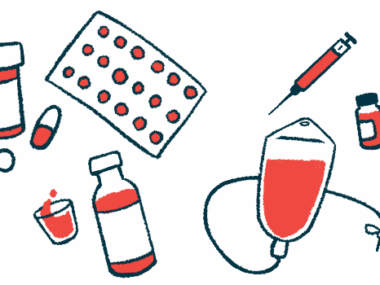A Spoonful of Sugar: My Diabetes Diagnosis, Part 1
Written by |

First in a two-part series.
Turns out a spoonful of sugar did not help the medicine go down. Instead, it aggravated my steroid-induced diabetes.
Allow me to provide a little background.
Based on issues I had throughout childhood, such as food sensitivities and digestive issues, my pediatric team suspected I had diabetes. However, my annual glucose tolerance test would always prove them wrong. At the worst, my sugar was a hair on the low side, even after years of steroid use.
Not too long ago, cystic fibrosis (CF) patients were encouraged to eat 5,000 calories a day to maintain their weight. Meaning, a family bucket of KFC and a large cola were always the menu.
As I aged, I kept to this diet. Worse, I grew addicted to it, so transitioning to a “normal” diet post-transplant was a challenge. Did you know people eat lettuce as a meal?!
By June 2020, one year post-transplant, my body was no longer burning through calories due to chronic infection, so my weight gain was visible. This wasn’t a bad thing. I was barely 80 pounds when I was transplanted, so even a dramatic gain of 20 pounds made me look healthier.
By 2021, however, with the addition of a half-dose of Trikafta (elexacaftor/tezacaftor/ivacaftor), my weight kept increasing, and I was concerned. My doctors told me not to worry because my body mass index was still in a healthy range, and the Trikafta weight would plateau eventually. Still, my bloated face and swollen belly left me feeling uncomfortable. All of this was in addition to the 10 mg of daily prednisone that hadn’t been tapered down since my transplant.
Last October, I started to feel unwell. We had just increased my Trikafta to the full dosage in the hope that it would suppress my lingering sinus disease. Unfortunately, this meant going through the medication side effects all over again — moodiness, fatigue, and the dreaded weight gain.
I voiced my concerns when I reached an all-time high of 125 pounds in November. I felt irritable and depressed. My feet and legs were swollen and sensitive. I could sleep for 24 hours without interruption. I was ravenous, and despite drinking a gallon of water a day, I was dehydrated.
Unfortunately, due to my collection of diseases and medications, all of these symptoms were easily explained by other things, such as worsened osteoporosis, a recent low-FODMAP diet (FODMAP refers to certain sugars that can cause intestinal issues), enzyme changes, seasonal depression, or immunosuppression.
On Jan. 5, it took every ounce of motivation I had to get out of bed. I had a long list of chores to accomplish, including a dentist appointment, and my morning treatment took twice as long due to overwhelming brain fog. Regardless, I made it to my appointment and was en route to pick up food when my mother called.
Everything I said on the call was very out of character, just a storm of anger and anxiety. Mom repeatedly asked me to pull over, but I insisted on grabbing Chick-fil-A before driving home and slumping on the couch. The vanilla shake and french fries hit the spot, or so I thought.
I went out again after a brief period of nausea and realized my vision was growing blurrier. I turned around and sped home to check my vitals. Something was clearly off. My blood pressure and oxygen were normal, but my blood sugar meter kept reading “HI.”
“Is this thing broken?” I asked the machine in frustration as I shook and slapped it.
I tried it three more times. HI. HI. HI.
Because none of my medical issues happen between the convenient hours of 9 a.m. and 5 p.m., I had to call the lung transplant doctor on call. They told me a reading of “HI” meant my blood sugar level was over 600 mg/dL, and I needed to have someone take me to the emergency room immediately. (The Mayo Clinic notes that a normal blood sugar level for adults is less than 140 mg/dL.)
My husband, Jared, drove me to the ER at CarolinaEast Medical Center in New Bern, North Carolina, where I waited behind over 100 coughing and vomiting patients for three hours. By the time I was examined, my blood sugar level was still high at 553 mg/dL. The medical staff immediately put me in an isolation room and started me on an insulin drip. They also placed me on sepsis protocol and administered a ton of IV fluids.
This was the beginning of a long seven days, during which I would learn that I had steroid-induced diabetes. While the moment contained more questions than answers, it was clear this spoonful of sugar was not going to go down in the most delightful way.
In the next column, I’ll share more details about my uphill battle with diabetes, including everything my doctors prescribed to treat it.
Note: Cystic Fibrosis News Today is strictly a news and information website about the disease. It does not provide medical advice, diagnosis, or treatment. This content is not intended to be a substitute for professional medical advice, diagnosis, or treatment. Always seek the advice of your physician or other qualified health provider with any questions you may have regarding a medical condition. Never disregard professional medical advice or delay in seeking it because of something you have read on this website. The opinions expressed in this column are not those of Cystic Fibrosis News Today, or its parent company, Bionews, and are intended to spark discussion about issues pertaining to cystic fibrosis.








Leave a comment
Fill in the required fields to post. Your email address will not be published.